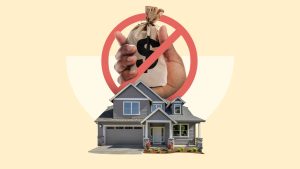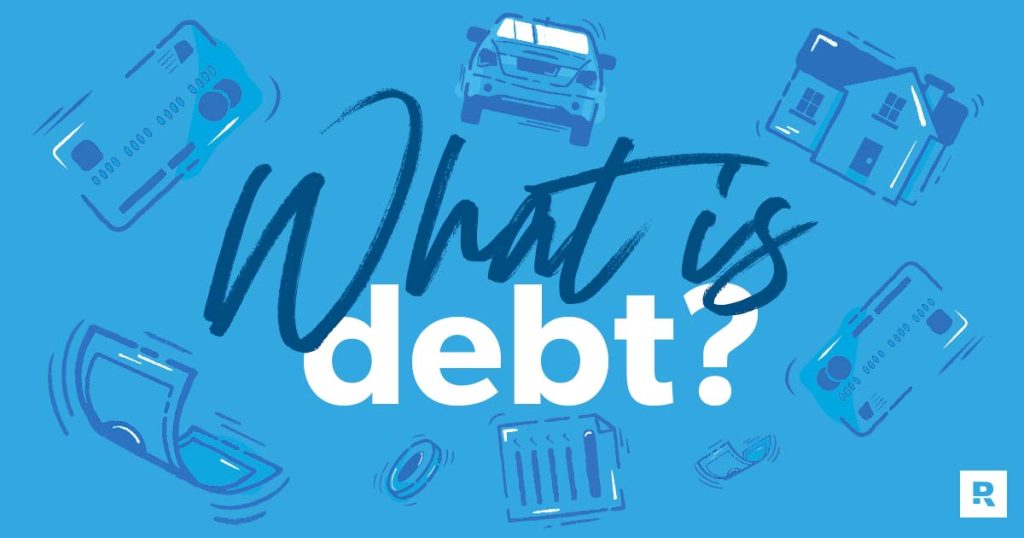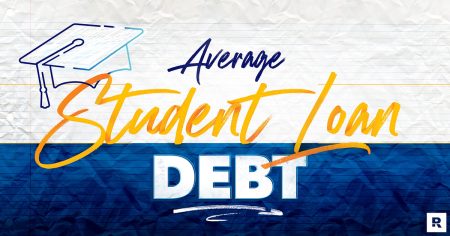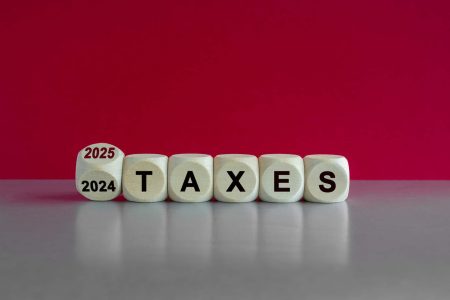“What is debt?” You’ve probably heard a lot of different answers and examples and advice . . . Heck, with so many opinions, it all gets confusing and honestly a little annoying.
Well, let’s get some straightforward clarity. How? By breaking down what debt actually is and how it works (in words a real human can understand).
From annoyed confusion to awesome clarity? Let’s do this.
What Is Debt?
In simple terms, debt is owing any money to anybody for any reason. But what about in legal terms?
What’s the legal definition of debt?
“Debt is a financial liability or obligation owed by one person, the debtor, to another, the creditor.”1 In other words, debt is when someone borrows money (a debtor) and is responsible for paying back the person or company who loaned them that money (the creditor or lender).
What’s the difference between debt and a loan?
Basically, a loan is a kind of debt. All loans are debt, but not all debt comes in the form of a loan. It’s like how a tortoise is a kind of a turtle. All tortoises are turtles, but not all turtles are tortoises. And if you didn’t know that—you learned two new things!
Understanding the Types of Debt
When we talk about types of debt, we’re talking about how the debt works. Does the lender make you put up collateral (something they can take if you don’t pay)? Is the debt a one-time loan or an open line you can keep borrowing from?
What does that all mean? Let’s break down the types of debt and see.
By the way, we’re about to use lots of debt vocab, but we’ve got a handy glossary of debt terms defined if you ever need to pop down and look at it!
Secured Debt
With secured debt, you’re borrowing money that’s backed by a physical item. In other words, there’s collateral. It’s a lower risk for lenders because they either get your money in payments or they take back what you “bought” and sell it. So, if you have a car loan and stop making your payments, the lender will take back your car and sell it to get their money back.
Unsecured Debt
With unsecured debt, there is no collateral. Credit card debt, for example, is unsecured debt. This type of debt is riskier for lenders since there isn’t anything they can take if you don’t pay—so unsecured debt often has higher interest rates to cover the lenders’ backs.
Revolving Debt
Revolving debt is an open line of credit (like a credit card or store credit card). You might have a set borrowing limit (called a credit limit), but if you make the minimum payment on time, you can keep borrowing and spending. But if that’s all you pay each month, you’ll have to worry about interest.
Nonrevolving Debt
A nonrevolving debt is when you take out one lump sum (like a mortgage) and agree to an interest rate and repayment plan.
Sneaky Debt
It would be just plain wrong of us not to mention sneaky debt. These are things you could pay cash for but you’re encouraged to finance instead—like buy now, pay later installment plans or anything a salesperson says you can take home today and pay off some other time. They might use words like “blah blah days same as cash” or “zero percent APR.”
It’s sneaky because it feels like a normal way to pay. In the moment. But remember, debt is owning any money to anybody for any reason. If you take something home now that you’ve promised to pay for over time, that’s debt.
Pay off debt fast and save more money with Financial Peace University.
Quick callout: Some debts can fit into more than just one type. For example, you can have a secured, nonrevolving debt like a mortgage. (We’ll explain that more under the mortgages section.)
What Are the Common Forms of Debt?
Okay, we’ve talked about the different types of debt. But we can’t fully answer “what is debt” without talking about the different forms or kinds too. Debt comes in all shapes, sizes and amounts. But here are some of the most common kinds.
Credit Card Debt
Basic Definition: A credit card is piece of plastic (or metal, if it’s fancy) that allows the cardholder to borrow money to pay for stuff. Credit card debt happens when the cardholder doesn’t pay off the total amount they charged to the card at the end of the month. At that point, the cardholder owes the remaining balance, plus interest.
Usage: Credit cards are pretty common. According to our own research, eight in 10 Americans have a credit card. Credit card debt? Also common. Altogether, 45% of Americans share a total of $804 billion in credit card debt.2,3
Debt Type: Credit cards fall under the revolving and unsecured debt types because a person can keep borrowing (as long as they’re paying the minimum payment and not maxing out their credit limit), and the lender doesn’t have an actual item they can take back from the cardholder if they stop making payments. That’s one reason a lender looks at a person’s income and credit score before setting a specific credit limit. Anyone who seems risky will be allowed to borrow less or pay higher interest rates.
Interest: One key part of credit cards is the interest, or the fee credit card companies charge to use their services. The average APR (annual percentage rate) on credit cards is 17.13% (as of winter 2021).4
Let’s do some math on that. If you multiply 17.13% by the $787 billion Americans owe, that’s about $134.81 billion credit card companies will make on interest alone. So, this kind of debt isn’t just common, it’s super profitable—for the credit card companies.
Student Loans
Basic Definition: A student loan is money borrowed to cover higher education costs.
Usage: Student loans are the fastest growing debt in America. As of winter 2021, the federal student loan debt total in America is 1.58 trillion.5 Yes, trillion. The majority of students (69%) leave school with at least some student loan debt.6
Debt Type: Student loans can be private or federal, and both are unsecured, nonrevolving debt. Of course, there are penalties for defaulting (or not paying) on your student loans, but no one comes and repossesses your degree. And it’s nonrevolving because, even though someone can take out multiple student loans, each one is a one-time loan for a specific purpose.
Interest: Interest rates vary a ton depending on what kind of student loan you’re talking about, but the average student loan interest rate is 5.8%.7
That might not seem like a lot, until you realize the average borrower has $38,792 in student loans and takes 20 years to pay that off.8,9
A quick run of those numbers through our Student Loan Calculator shows that “not a lot” 5.8% turns into $26,936.89 paid in interest alone over those 20 years. I think we can all agree: That is a lot.
Auto Loans
Basic Definition: A car loan is money someone borrows to purchase a car.
Usage: American auto loan debt is at $1.44 trillion with an average of $31,758 per household (winter 2021).10, 11,12,13
Debt Type: Auto loans are nonrevolving, secured debt because it’s one lump loan, and the car acts as collateral. If you don’t make payments on the car, goodbye, car. The lender can take it back, sell it cheap at auction, and sue you for the difference. Yes, really.
Interest: The average interest rate for a new car is 4.09% and 8.66% for a used car.14
We ran those numbers through our Auto Loan Calculator. If you bought a $31,142 used car at that 8.66% interest rate with a 60-month auto loan, you’d end up paying $7,338 just in interest. Yuck.
Personal Loans
Basic Definition: Personal loans are a lump sum borrowed from a bank, credit union, or online lender.
Usage: This kind of debt is often used to cover a specific expense or in a (risky) attempt at debt consolidation. In other words, sometimes people take out a personal loan to pay off other loans. Hmm.
Twenty-two percent (22%) of American adults have a personal loan and owe an average of $16,458.15
Debt Type: Personal loans are nonrevolving debt, but they can be secured or unsecured. It all depends on the loan terms, which are whatever the lender wants them to be.
Interest: Interest rates on personal loans can vary based on how reliable the lender thinks the borrower will be. If a person is considered a higher risk of not paying back their debt, they’ll get slapped with a higher interest rate.
Mortgages
Basic Definition: A mortgage is a loan taken out from a lender to help you buy a house.
Usage: Forty-two percent of households have mortgages, with a median monthly payment of $1,595 and an average mortgage debt per household of $202,454 (summer 2021).16,17,18,19
Debt Type: Mortgages are secured because the lender can force the sale of the home through a foreclosure if the homeowner defaults or stops making payments. They are also nonrevolving debt because a mortgage is one lump sum borrowed to purchase a home.
Interest: In 2021, the average interest rate for a 15-year, fixed-rate mortgage (which is totally the best way to go) was historically low—at 2.15–2.39%.20
HELOCs
Basic Definition: A HELOC (aka home equity line of credit) is when you borrow on the equity of your home. The equity is the difference between what the house is worth and what you still owe on your mortgage. So, with a HELOC, you’re giving up the equity you’ve earned and trading it in for more debt. Again, yuck.
Usage: There are more than 4.7 million HELOCs (totaling $349 billion) in America, and the average American household with this type of debt owes $73,685.21,22
Debt Type: Since your home can be taken away if you don’t pay on your HELOC, it’s a secured debt. Since it’s a line of credit, a HELOC is revolving debt.
Interest: Fixed interest rates with a HELOC are super rare, so expect them to go up at the lender’s whim.
Debt Terms Defined
Okay, we’ve been using a lot of debt lingo. Here are some clear definitions on common debt terms.
APR: APR stands for annual percentage rate. Some people think it’s the same thing as an interest rate, but APR is the interest rate plus fees. Drop that bit of knowledge at your next party and wow your friends. (Results may vary depending on your friends.)
Bankruptcy: Bankruptcy is the legal process of telling a judge you can’t pay off your debt. If the court agrees after a thorough review, they’ll erase some of your debt.
Balance: How much you owe on a debt is the balance. For example, if you pay off the balance of a credit card, you no longer owe on it. If you “carry a balance,” that means you aren’t paying off the full amount, and you have credit card debt that will be charged interest. (P. S. If you never use a credit card, you’ll never owe on it. Just saying.)
Borrower: A borrower is the person taking on the debt from a lender or creditor.
Business debt: This is money you’ve borrowed to run your business.
Collateral: Collateral is property (like a car, home, etc.) a lender can take if you stop making payments on your debt.
Collections: If a borrower stops paying, the debt can go to collections. To be fair, the lender has a right to get their money back. But they (or any collections companies the lender might hire) should follow the guidelines and laws set up to keep them from straight-up harassing a borrower.
Credit limit: The max amount you can borrow or charge is a credit limit. It’s often set based on income, credit score and other factors.
Credit report: Credit reports are super detailed statements about your past and present credit activity. It’s important to check in on your credit report for any mistakes—and even fraud—at least once a year.
Credit score: Your credit score is a number based on your credit history that most lenders use to decide if you seem reliable enough to pay back your debts. But it doesn’t consider your actual wealth—just how “well” you juggle and how much you use debt. That’s why we call it an “I love debt” score.
Creditworthiness: This refers to how reliable a lender thinks you’ll be in paying off your debt (usually based on how reliably you’ve done it in the past).
Debt: Debt is owing any money to anybody for any reason.
Debt consolidation: This is the process of combining several debts into one monthly bill on a streamlined payoff plan, but it typically keeps the borrower in debt even longer and usually comes with fees and higher interest rates.
Debt snowball: The debt snowball is the best way to become debt-free by paying off debt smallest to largest. (We’ll break it down more in a bit.)
Delinquent: The moment you miss a payment, a loan becomes delinquent.
Default: If you go too long without making payments, your loan will move from delinquency to default.
FICO: The most common credit score system is FICO. (It’s another turtle and tortoise situation. FICO is one kind of credit score, but not all credit scores are FICO.)
Your FICO score is calculated like this: payment history (35%), amounts owed (30%), length of credit history (15%), credit mix (10%), and new credit (10%).24 Yeah, it’s all about your relationship to debt—not your responsibility with money.
Interest rate: An interest rate is a percentage the lender charges you for borrowing money.
Lenders: The ones loaning the money are called lenders (or creditors). Private companies, banks, credit unions, friends, family and even the government can act as lenders.
Loan term: A loan term is the amount of time you have to pay back the loan.
Minimum payment: The smallest amount you’re allowed to pay on your revolving debt is called the minimum payment. Usually, if you’re covering just this, you’re getting charged interest for the remaining balance.
Payday loans: Payday loans are a way for you to borrow money before your next paycheck. Payday lenders take their cut once you’re paid (plus lots of interest). Since you just lost so much of your income, you’ll probably have to take out another payday loan to make it to your next paycheck. See what a horrible cycle they suck you into?
Payment: The amount of money you hand over per month to pay back your loan is the payment.
Principal: The principal of a loan is the total amount that was borrowed. This doesn’t include interest.
Student loan consolidation: Student loan consolidation is the process of rolling multiple federal student loans into a single loan with one monthly payment. It also lets you trade any variable interest rates for a fixed rate. Student loan consolidation is the only kind of debt consolidation we’re okay with. But because consolidation usually extends the length of your loan, you need to pay more than the minimum payment to keep from forking over a ton of extra money to interest alone.
Validation letter: A very detailed note the debt collector sends to prove that you owe them money is a validation letter.
Zombie debt: Old debt that’s come back to haunt you is called zombie debt. (Perfect name, right?) If a collector tries to bring up zombie debt, watch your back. They aren’t after your brains, just your wallet. It might be something you still have to pay off—or it could be identity theft or a scam.
Disadvantages of Debt
Here’s the main problem with debt: Your income is your greatest wealth-building tool. But debt is all about paying off the past—putting this month’s income to something you bought last month, last year, or even longer ago. You can’t move forward like that.
Debt holds your income hostage. It holds your future hostage.
But you can take back your income. All of it. How?
How to Get Rid of Debt. For Good.
The absolute best way to get rid of all your debt—so you can be the one in control of your own money—is the debt snowball method. Here’s how you use it:
List your debts in order from the smallest balance to largest.
Go after the smallest debt first. Put any extra money you can toward that debt. (Pro tip: Lower your spending, up your income, or both to make this happen!) While you’re attacking the smallest debt, keep paying the minimum on the rest.
Once you’ve paid off the smallest debt, start on the second smallest. Take everything you were throwing at your smallest debt and add it to the minimum payment of the second.
Once you’ve paid off that one, move to the next one, then the next . . . Keep going until you’ve paid off everything.
This is why it works: Imagine a snowball rolling downhill. (No really, imagine it.) It gains size and speed as it goes. The debt snowball has you doing the same thing with your debt, knocking out each and every one—and gaining awesome momentum and motivation as you go.
When you start with the smallest debt, you get a quick win early on. That gets you super pumped to keep rocking and rolling until you’re completely debt-free.
Want to find out how big an impact you’ll make on your whole life when you’re finally debt-free? Want to hear from regular people who’ve done it?
Three words: Financial Peace University. Jump in and watch lessons one and two. Like right now. You’ll learn what it takes to pay off debt and get pumped to get debt out of your life. For good.
Because you don’t have to owe. You don’t have to be tied to payments. You don’t have to do the minimum here. You can be in control and call the shots.
You just have to take the first step.
Read the full article here










